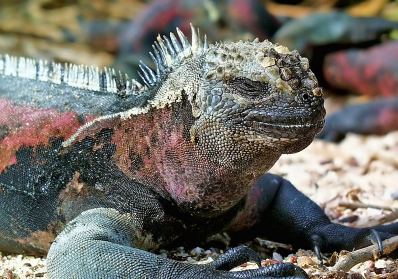Commas for lists: marine iguana
The Grammar Bit!
Read the three sentences opposite. They each contain a list of three or more items or actions.
In each list sentence, you’ll notice that commas (bold) have been used to separate the individual items or actions. It is usual to replace the comma between the final two items/actions with the coordinating conjunction ‘and’.
With your talk partner, read each sentence aloud and add a new item to the list. Where there is a comma, clap your hands.
Scintillating Sentences
1) A marine iguana is a cold-blooded reptile with sharp teeth, a blunt snout, a long tail and a salt-encrusted head.
2) As the waves crashed against the cliff, the angry cormorant pecked the iguana’s head, neck, tail and legs.
3) When Charles Darwin first sighted the marine iguanas of the Galápagos Islands, he described them as being ‘hideous-looking’, ‘most disgusting’ and ‘clumsy lizards’.

Did you know?
When diving for food, a marine iguana swallows a large amount of saltwater. When on land, it ‘sneezes’ out unwanted salt from its body. The salt often lands on the reptile’s head, where it forms a white crust.

